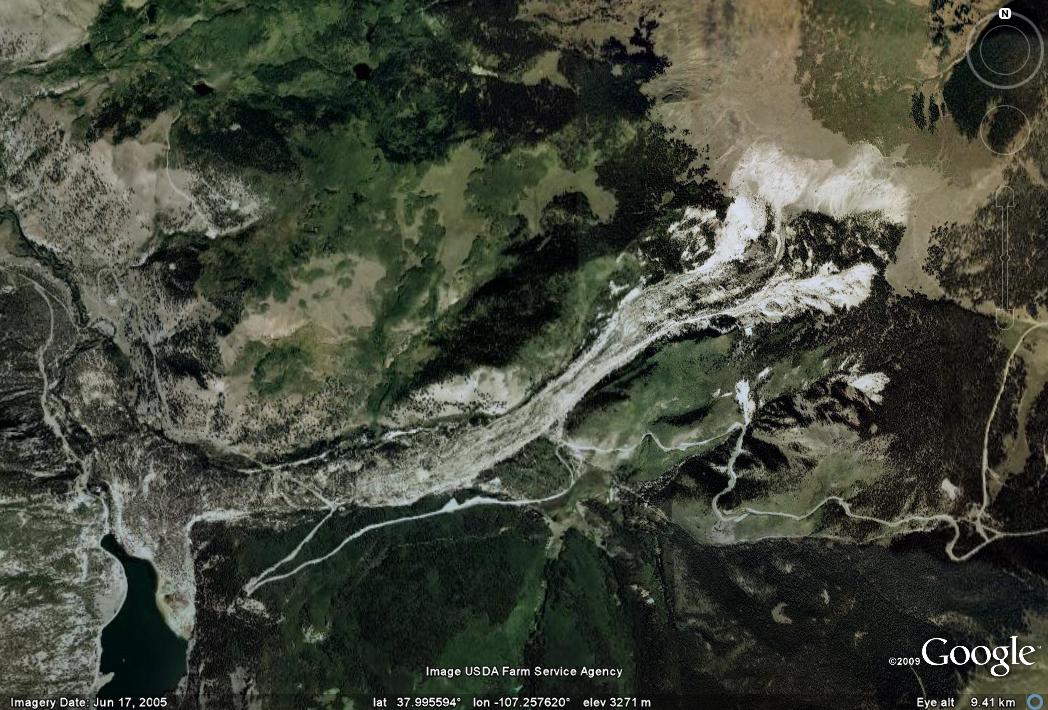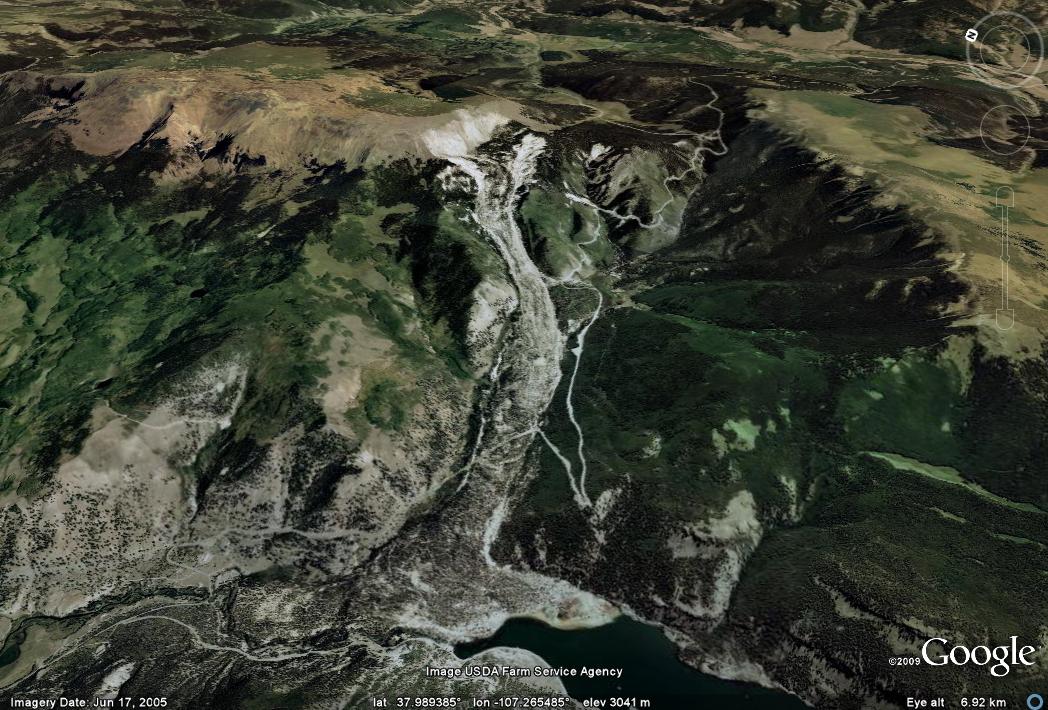1 November 2009
A very surprising paper – movement of a landslide controlled by atmospheric tides
Posted by Dave Petley
![]() Just occasionally a paper appears that makes me sit up with surprise, with a strong sense of “I did not see that one coming!”. Just such a paper has appeared in pre-publication form in Nature Geoscience today – namely Schultz et al. (2009). This will undoubtedly represent the most surprising landslide paper of the year, and indeed for a few years in fact. I suspect that this paper will generate a fair amount of media interest in the next few days as well.
Just occasionally a paper appears that makes me sit up with surprise, with a strong sense of “I did not see that one coming!”. Just such a paper has appeared in pre-publication form in Nature Geoscience today – namely Schultz et al. (2009). This will undoubtedly represent the most surprising landslide paper of the year, and indeed for a few years in fact. I suspect that this paper will generate a fair amount of media interest in the next few days as well.
The subject of the paper is the Slumgullion landslide in SW. Colorado. This slide is a classic landslide site – it is large and moves almost continually. The slide is pretty obvious on Google Earth:
 All the more so when viewed obliquely:
All the more so when viewed obliquely:
 And there are a fair number of websites and online materials that describe it (see here and here for example).
And there are a fair number of websites and online materials that describe it (see here and here for example).
This latest study is based on an intense monitoring campaign undertaken on the landslide using extension transducers. There is little doubt that the monitoring has been designed with great care by a team that is well-versed in such techniques. The team have used this movement data to examine the variation in movement through time. There is nothing terribly unusual about this approach except perhaps the level of precision with which the monitoring has been undertaken, but the results are very intriguing. The data suggest that the slide moves almost every day. This style of behaviour is quite unusual – most landslides are very episodic in terms of movement – but certainly not unique. However, examination the movement patterns on a daily basis suggested that the slide moved in distinct eight hour periods, essentially at night. During the day the landslide was to all intents and purposes stationary. This periodic movement of the slide was found to be correlated with the variations in air pressure associated with atmospheric tides – i.e. it appears that the movement of the slide is controlled by air pressure! Atmospheric tides are small variations in atmospheric pressure that result from solar heating of the air. The patterns of atmospheric tides are actually rather complex, but can be examined with a Fourier analysis.
The team have compared the Fourier analysis of the movement pattern of the landslide with that of the atmospheric tides – there is little doubt that they are remarkably similar. Thus the movement at least appears to be related to these atmospheric tidal cycles. The authors suggest that these low atmospheric tide conditions induce upward movement of water and air below the shear surface of the landslide, changing the “frictional stress” of the slide, allowing movement to occur. They have modelled the slide to explore this mechanism and present an analysis that, at least on first inspection, appears to be credible and to support their hypothesis.
Now, it must be stressed at this point that Slumgullion is not a typical landslide. In particular, the perennial slow landslide movement suggests that the factor of safety is essentially unity. Measurements suggest that the pore pressure on the shear surface varies very little on the landslide, meaning that the slide is potentially highly sensitive to effects such as that reported in Schulz et al. (2009). It is very unlikely that this effect is seen in anything other than a small proportion of slides that have exactly the right combination of stress state, thickness and material properties to allow this to occur, although I am willing to bet that a small number of other slides will be found to display this behaviour. However, as the authors of the paper hint, the most interesting aspect may well be the implications for landslides in areas that encounter conditions with very low atmospheric pressures. The key mechanism to deliver such conditions is the tropical cyclone, especially typhoons in East Asia and hurricanes in the Caribbean. Here, atmospheric pressures can drop very low (Typhoon Tip had a measured sea level air pressure of 870 hPa in 1970), as well as bringing high intensity rainfall of course. Thus, it may well be that the very high incidence of landslides under such conditions is not just the consequence of the rainfall but also the low atmospheric pressure. That is a very interesting observation indeed. Added to the recent observations that tropical cyclones can also trigger slow earthquakes, our understanding of the interactions between the atmosphere and the ground is developing quickly.
So, all in all this is a fascinating study for which the authors should be congratulated. It has added an intriguing new dimension to landslides, and will I suspect trigger a new wave of research projects. I should add here that for most landslides this effect is almost certainly very small (no-one living near a landslide should start worrying about atmospheric pressures – it is still rainfall and earthquakes that are the main issue), but for certain slides under certain conditions this may be an important effect.
Reference
Schulz, W.H., Kean, J.W and Wang, G. (2009). Landslide movement in southwest Colorado triggered by atmospheric tides Nature Geoscience : 10.1038/NGEO65


 Dave Petley is the Vice-Chancellor of the University of Hull in the United Kingdom. His blog provides commentary and analysis of landslide events occurring worldwide, including the landslides themselves, latest research, and conferences and meetings.
Dave Petley is the Vice-Chancellor of the University of Hull in the United Kingdom. His blog provides commentary and analysis of landslide events occurring worldwide, including the landslides themselves, latest research, and conferences and meetings.
Twenty-five or thirty years ago Charlie Baskerville gave a 5-minute talk at the Geological Society of Washington (never published as far as I know) pointing out a correlation between low atmospheric pressure and landslides in New England. He had some direct mechanism I've forgotten but doubted at the time. I thought more likely low P meant a high P gradient, hence high winds, so forests acted a fleet of ships with sails set and dragging anchor.But maybe there's something to be looked at anew.
Very interesting, the periodicity.
I work in open pit mining and with some very large slides we have observed a correlation between slope movement and low pressure weather systems. Speculation is that lower pressure causes groundwater to rise, thereby lubricating or reducing shear strength within the slide and spiking velocity. This observation occurs even prior to receiving precipitation.
Many institutions limit access to their online information. Making this information available will be an asset to all.
Many institutions limit access to their online information. Making this information available will be an asset to all.
No news to us! Hydrogeologists know this phenomenon in confined aquifers since decades. This is the reason that, while monitoring pore water pressure in slides, we also measure (or compensate for) atmospheric pressure!
[…] So this is where you can play a role. We are trying to create a database of landslides that have passed through (or been stopped by) a constriction. By this we mean a point in which the track or channel narrows. An example is the Slumgullion landslide in Colorado, which goes through a fairly gentle constriction along track (images from my earlier post about the landslide): […]